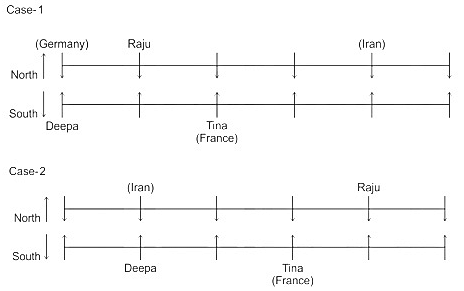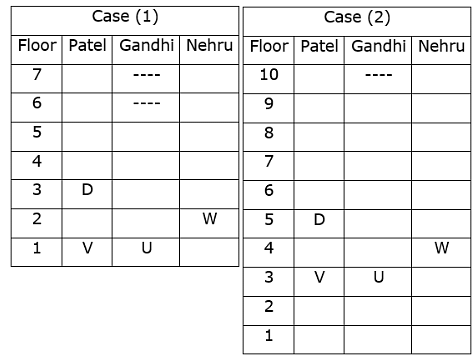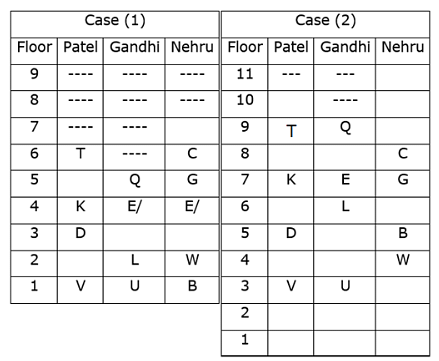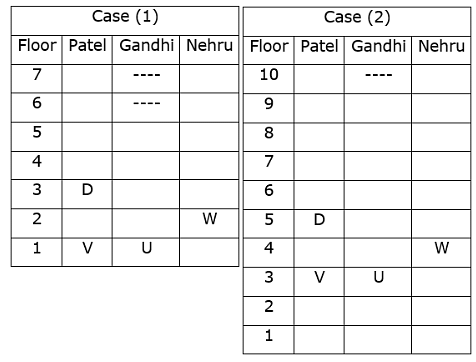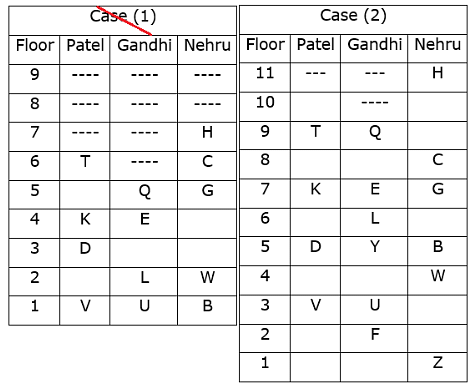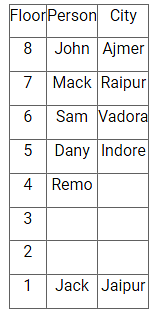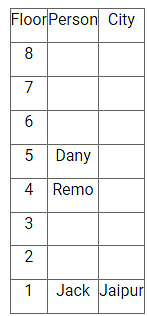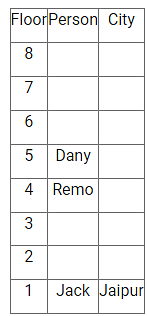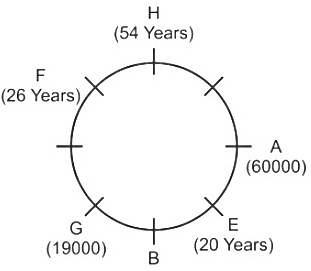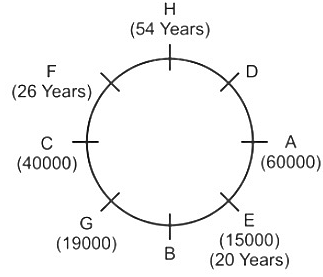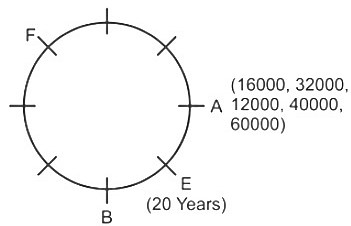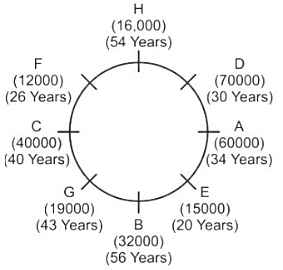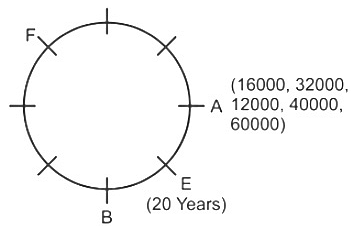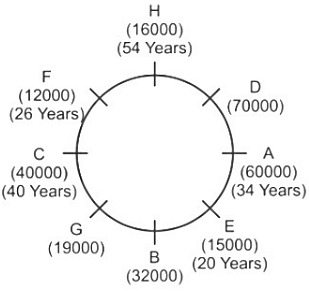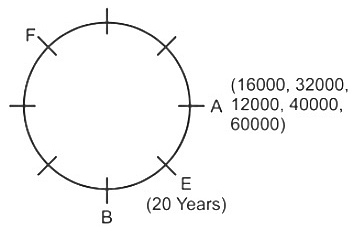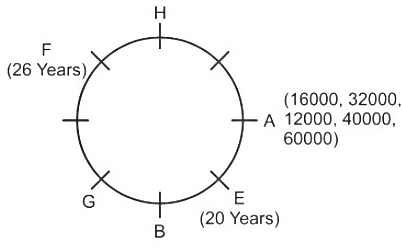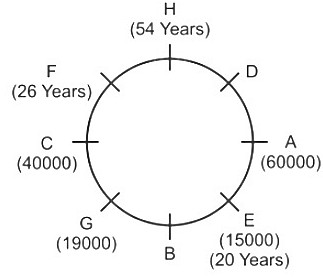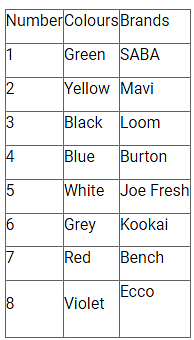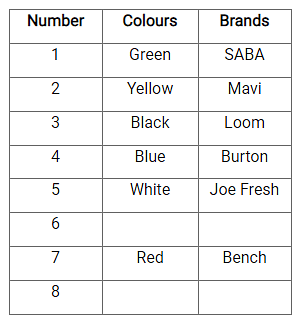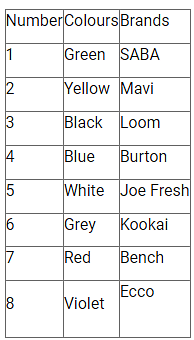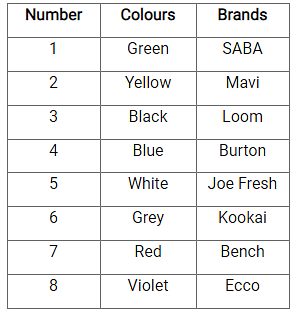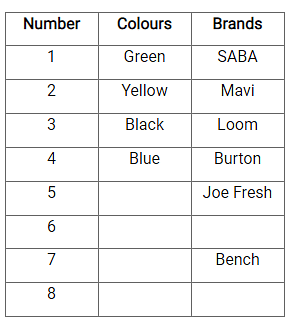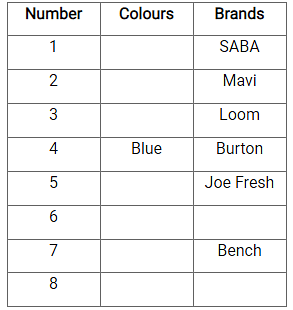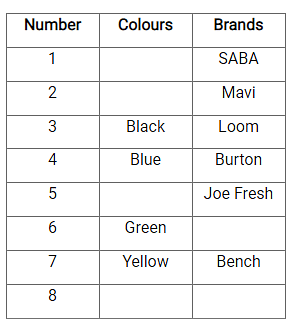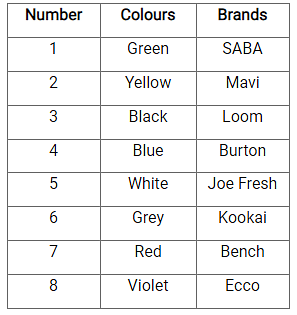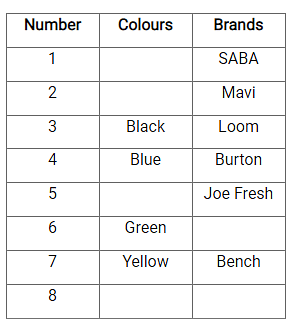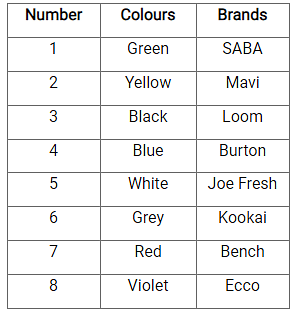IBPS PO Mains Mock Test - 10 - Bank Exams MCQ
30 Questions MCQ Test Mock Tests for Banking Exams 2024 - IBPS PO Mains Mock Test - 10
Direction: Study the following information and answer the given question:
12 people belong to different countries: India, China, Japan, Russia, France, Germany, Italy, Iran, Spain, Israel, America and Australia. are seated in two parallel rows with six people in each row such that there is equal distance between the adjacent persons and each person in one row faces the person in another row. In row 1, Rinky, Pinky, Raju, Tony, Nisha, and Nil are seated facing South and in row 2, Deepa, Ajay, Rina, Tina, Mina and Shyam are seated facing North not necessarily in the same order. Two persons sits between Raju and the one who belongs to Iran. Neither of them sits at the extreme ends of the row. The one who faces Raju is an immediate neighbour of Tina who belongs to France. Tina does not sit at the end of the row. Deepa sits second to the left of Tina. Deepa faces the one who belongs to Germany. Nil who belongs to Japan sits in front of the one who belongs to Spain. The one who belongs to Spain is not an immediate neighbour of Tina. The one who belongs to China sits second to the right of Ajay. Nisha belongs to India and does not sits in front of Tina. Rinky is not an immediate neighbour of Nisha. Tony sits in front of Mina who belongs to Russia. Shyam does not belongs to Spain. Neither Pinky nor Ajay belongs to Italy and America. The one who belongs to Italy does not sit at any of the extreme ends of the row. Ajay does not belong to Australia.
Who is sitting between Tina and Deepa?
Direction: Study the following information and answer the given question:
12 people belong to different countries: India, China, Japan, Russia, France, Germany, Italy, Iran, Spain, Israel, America and Australia. are seated in two parallel rows with six people in each row such that there is equal distance between the adjacent persons and each person in one row faces the person in another row. In row 1, Rinky, Pinky, Raju, Tony, Nisha, and Nil are seated facing South and in row 2, Deepa, Ajay, Rina, Tina, Mina and Shyam are seated facing North not necessarily in the same order. Two persons sits between Raju and the one who belongs to Iran. Neither of them sits at the extreme ends of the row. The one who faces Raju is an immediate neighbour of Tina who belongs to France. Tina does not sit at the end of the row. Deepa sits second to the left of Tina. Deepa faces the one who belongs to Germany. Nil who belongs to Japan sits in front of the one who belongs to Spain. The one who belongs to Spain is not an immediate neighbour of Tina. The one who belongs to China sits second to the right of Ajay. Nisha belongs to India and does not sits in front of Tina. Rinky is not an immediate neighbour of Nisha. Tony sits in front of Mina who belongs to Russia. Shyam does not belongs to Spain. Neither Pinky nor Ajay belongs to Italy and America. The one who belongs to Italy does not sit at any of the extreme ends of the row. Ajay does not belong to Australia.
Who belongs to Australia?
| 1 Crore+ students have signed up on EduRev. Have you? Download the App |
Direction: Study the following information and answer the given question:
12 people belong to different countries: India, China, Japan, Russia, France, Germany, Italy, Iran, Spain, Israel, America and Australia. are seated in two parallel rows with six people in each row such that there is equal distance between the adjacent persons and each person in one row faces the person in another row. In row 1, Rinky, Pinky, Raju, Tony, Nisha, and Nil are seated facing South and in row 2, Deepa, Ajay, Rina, Tina, Mina and Shyam are seated facing North not necessarily in the same order. Two persons sits between Raju and the one who belongs to Iran. Neither of them sits at the extreme ends of the row. The one who faces Raju is an immediate neighbour of Tina who belongs to France. Tina does not sit at the end of the row. Deepa sits second to the left of Tina. Deepa faces the one who belongs to Germany. Nil who belongs to Japan sits in front of the one who belongs to Spain. The one who belongs to Spain is not an immediate neighbour of Tina. The one who belongs to China sits second to the right of Ajay. Nisha belongs to India and does not sits in front of Tina. Rinky is not an immediate neighbour of Nisha. Tony sits in front of Mina who belongs to Russia. Shyam does not belongs to Spain. Neither Pinky nor Ajay belongs to Italy and America. The one who belongs to Italy does not sit at any of the extreme ends of the row. Ajay does not belong to Australia.
Which country does Rina belongs to?
Direction: Study the following information and answer the given question:
12 people belong to different countries: India, China, Japan, Russia, France, Germany, Italy, Iran, Spain, Israel, America and Australia. are seated in two parallel rows with six people in each row such that there is equal distance between the adjacent persons and each person in one row faces the person in another row. In row 1, Rinky, Pinky, Raju, Tony, Nisha, and Nil are seated facing South and in row 2, Deepa, Ajay, Rina, Tina, Mina and Shyam are seated facing North not necessarily in the same order. Two persons sits between Raju and the one who belongs to Iran. Neither of them sits at the extreme ends of the row. The one who faces Raju is an immediate neighbour of Tina who belongs to France. Tina does not sit at the end of the row. Deepa sits second to the left of Tina. Deepa faces the one who belongs to Germany. Nil who belongs to Japan sits in front of the one who belongs to Spain. The one who belongs to Spain is not an immediate neighbour of Tina. The one who belongs to China sits second to the right of Ajay. Nisha belongs to India and does not sits in front of Tina. Rinky is not an immediate neighbour of Nisha. Tony sits in front of Mina who belongs to Russia. Shyam does not belongs to Spain. Neither Pinky nor Ajay belongs to Italy and America. The one who belongs to Italy does not sit at any of the extreme ends of the row. Ajay does not belong to Australia.
Who is sitting in front of Shyam?
Study the following information carefully and answer the below questions.
A certain number of persons are living in the building. There are three apartments viz.- Patel, Gandhi, and Nehru from west to east respectively. The number of floors in each apartment is not the same. At least five and not more than eleven floors are there in each apartment. Only one person lives on each floor of each apartment and there is no vacant floor. Information about only a few of them is known. The lowermost floor is numbered as 1 and the floor immediately above it is numbered as 2 and so on.
Note: If X lives west of Y, that means X and Y both live on the same floor of different apartments. Similarly, if X lives northwest of Y that means both X and Y are living on the diagonal floors of the different apartments. If X lives two floors above or below Y, then both are living in the same apartment.
V lives two floors below D, who lives on an odd numbered floor. U lives immediate southwest of W and lives immediate east of V. The number of floors in Gandhi apartment is one more than twice the number of floors below D. The number of floors in Nehru apartment is the maximum. Q lives three floors above L, who lives immediate northwest of B. Q and G are not living in the same apartment. The number of floors in Patel apartment is one more than the number of floors in Gandhi apartment. G lives northeast of D, who lives in the same apartment as K. The number of floors below L is one less than twice the number of floors above C, who lives immediately above G. T lives two floors above K, who lives in the west of E. K and L are not living in the same apartment. The number of floors above K is half of the number of floors below G. U does not live northwest of B. H lives on the topmost floor of one of the apartments but not lives in the same apartment as E. Neither H nor F lives in the Patel apartment. F lives northwest of Z and lives three floors below Y who does not live above floor number 6.
What is the position of the one who lives three floors below H with respect to Q?
Study the following information carefully and answer the below questions.
A certain number of persons are living in the building. There are three apartments viz.- Patel, Gandhi, and Nehru from west to east respectively. The number of floors in each apartment is not the same. At least five and not more than eleven floors are there in each apartment. Only one person lives on each floor of each apartment and there is no vacant floor. Information about only a few of them is known. The lowermost floor is numbered as 1 and the floor immediately above it is numbered as 2 and so on.
Note: If X lives west of Y, that means X and Y both live on the same floor of different apartments. Similarly, if X lives northwest of Y that means both X and Y are living on the diagonal floors of the different apartments. If X lives two floors above or below Y, then both are living in the same apartment.
V lives two floors below D, who lives on an odd numbered floor. U lives immediate southwest of W and lives immediate east of V. The number of floors in Gandhi apartment is one more than twice the number of floors below D. The number of floors in Nehru apartment is the maximum. Q lives three floors above L, who lives immediate northwest of B. Q and G are not living in the same apartment. The number of floors in Patel apartment is one more than the number of floors in Gandhi apartment. G lives northeast of D, who lives in the same apartment as K. The number of floors below L is one less than twice the number of floors above C, who lives immediately above G. T lives two floors above K, who lives in the west of E. K and L are not living in the same apartment. The number of floors above K is half of the number of floors below G. U does not live northwest of B. H lives on the topmost floor of one of the apartments but not lives in the same apartment as E. Neither H nor F lives in the Patel apartment. F lives northwest of Z and lives three floors below Y who does not live above floor number 6.
Four of the following five are alike in a certain way based on the given arrangement and thus form a group. Which one of the following does not belong to the group?
Study the following information carefully and answer the below questions.
A certain number of persons are living in the building. There are three apartments viz.- Patel, Gandhi, and Nehru from west to east respectively. The number of floors in each apartment is not the same. At least five and not more than eleven floors are there in each apartment. Only one person lives on each floor of each apartment and there is no vacant floor. Information about only a few of them is known. The lowermost floor is numbered as 1 and the floor immediately above it is numbered as 2 and so on.
Note: If X lives west of Y, that means X and Y both live on the same floor of different apartments. Similarly, if X lives northwest of Y that means both X and Y are living on the diagonal floors of the different apartments. If X lives two floors above or below Y, then both are living in the same apartment.
V lives two floors below D, who lives on an odd numbered floor. U lives immediate southwest of W and lives immediate east of V. The number of floors in Gandhi apartment is one more than twice the number of floors below D. The number of floors in Nehru apartment is the maximum. Q lives three floors above L, who lives immediate northwest of B. Q and G are not living in the same apartment. The number of floors in Patel apartment is one more than the number of floors in Gandhi apartment. G lives northeast of D, who lives in the same apartment as K. The number of floors below L is one less than twice the number of floors above C, who lives immediately above G. T lives two floors above K, who lives in the west of E. K and L are not living in the same apartment. The number of floors above K is half of the number of floors below G. U does not live northwest of B. H lives on the topmost floor of one of the apartments but not lives in the same apartment as E. Neither H nor F lives in the Patel apartment. F lives northwest of Z and lives three floors below Y who does not live above floor number 6.
How many persons are living below U in the same apartment?
Study the following information carefully and answer the below questions.
A certain number of persons are living in the building. There are three apartments viz.- Patel, Gandhi, and Nehru from west to east respectively. The number of floors in each apartment is not the same. At least five and not more than eleven floors are there in each apartment. Only one person lives on each floor of each apartment and there is no vacant floor. Information about only a few of them is known. The lowermost floor is numbered as 1 and the floor immediately above it is numbered as 2 and so on.
Note: If X lives west of Y, that means X and Y both live on the same floor of different apartments. Similarly, if X lives northwest of Y that means both X and Y are living on the diagonal floors of the different apartments. If X lives two floors above or below Y, then both are living in the same apartment.
V lives two floors below D, who lives on an odd numbered floor. U lives immediate southwest of W and lives immediate east of V. The number of floors in Gandhi apartment is one more than twice the number of floors below D. The number of floors in Nehru apartment is the maximum. Q lives three floors above L, who lives immediate northwest of B. Q and G are not living in the same apartment. The number of floors in Patel apartment is one more than the number of floors in Gandhi apartment. G lives northeast of D, who lives in the same apartment as K. The number of floors below L is one less than twice the number of floors above C, who lives immediately above G. T lives two floors above K, who lives in the west of E. K and L are not living in the same apartment. The number of floors above K is half of the number of floors below G. U does not live northwest of B. H lives on the topmost floor of one of the apartments but not lives in the same apartment as E. Neither H nor F lives in the Patel apartment. F lives northwest of Z and lives three floors below Y who does not live above floor number 6.
Which of the following statement(s) is/are true?
I. F lives to the southeast of the one who lives two floors below D.
II. W lives four floors below the one who lives immediate east of Y.
III. T lives immediate northwest of Q.
Direction: Read the information carefully and answer the questions given below.
Eight persons - John, Dany, Sunny, Remo, Piyush, Mack, Jack and Sam living in an eight-floor building and all of them belong to different cities Jaipur, Ajmer, Raipur, Indore, Mathura, Bhopal, Godhra and Vadodara but not necessarily in the same order. The lowermost floor is 1 and the topmost floor is 8. Only one person belong to one city.
John lives on an even-numbered floor and belongs to Ajmer. Jack lives on the lowermost floor and belongs to Jaipur. At least four people live below John. Mack lives immediately below John. There are two people living between Jack and Remo. Sam lives immediately above Dany and belongs to Vadodara. Dany lives immediately above Remo. Sunny lives above Piyush. Remo lives immediately below person belongs to Indore. The person belonging to Raipur lives between John and Sam. The person belonging to Bhopal lives immediately below the person belonging to Mathura and immediately above the person belonging to Godhra.
How many persons live below Dany?
Direction: Read the information carefully and answer the questions given below.
Eight persons - John, Dany, Sunny, Remo, Piyush, Mack, Jack and Sam living in an eight-floor building and all of them belong to different cities Jaipur, Ajmer, Raipur, Indore, Mathura, Bhopal, Godhra and Vadodara but not necessarily in the same order. The lowermost floor is 1 and the topmost floor is 8. Only one person belong to one city.
John lives on an even-numbered floor and belongs to Ajmer. Jack lives on the lowermost floor and belongs to Jaipur. At least four people live below John. Mack lives immediately below John. There are two people living between Jack and Remo. Sam lives immediately above Dany and belongs to Vadodara. Dany lives immediately above Remo. Sunny lives above Piyush. Remo lives immediately below person belongs to Indore. The person belonging to Raipur lives between John and Sam. The person belonging to Bhopal lives immediately below the person belonging to Mathura and immediately above the person belonging to Godhra.
Who lives on the topmost floor?
Direction: Read the information carefully and answer the questions given below.
Eight persons - John, Dany, Sunny, Remo, Piyush, Mack, Jack and Sam living in an eight-floor building and all of them belong to different cities Jaipur, Ajmer, Raipur, Indore, Mathura, Bhopal, Godhra and Vadodara but not necessarily in the same order. The lowermost floor is 1 and the topmost floor is 8. Only one person belong to one city.
John lives on an even-numbered floor and belongs to Ajmer. Jack lives on the lowermost floor and belongs to Jaipur. At least four people live below John. Mack lives immediately below John. There are two people living between Jack and Remo. Sam lives immediately above Dany and belongs to Vadodara. Dany lives immediately above Remo. Sunny lives above Piyush. Remo lives immediately below person belongs to Indore. The person belonging to Raipur lives between John and Sam. The person belonging to Bhopal lives immediately below the person belonging to Mathura and immediately above the person belonging to Godhra.
How many persons live below Mack and above Remo?
Direction: Read the information carefully and answer the questions given below.
Eight persons - John, Dany, Sunny, Remo, Piyush, Mack, Jack and Sam living in an eight-floor building and all of them belong to different cities Jaipur, Ajmer, Raipur, Indore, Mathura, Bhopal, Godhra and Vadodara but not necessarily in the same order. The lowermost floor is 1 and the topmost floor is 8. Only one person belong to one city.
John lives on an even-numbered floor and belongs to Ajmer. Jack lives on the lowermost floor and belongs to Jaipur. At least four people live below John. Mack lives immediately below John. There are two people living between Jack and Remo. Sam lives immediately above Dany and belongs to Vadodara. Dany lives immediately above Remo. Sunny lives above Piyush. Remo lives immediately below person belongs to Indore. The person belonging to Raipur lives between John and Sam. The person belonging to Bhopal lives immediately below the person belonging to Mathura and immediately above the person belonging to Godhra.
Who belongs to Godhra?
Direction: Read the information carefully and answer the questions given below.
Eight persons - John, Dany, Sunny, Remo, Piyush, Mack, Jack and Sam living in an eight-floor building and all of them belong to different cities Jaipur, Ajmer, Raipur, Indore, Mathura, Bhopal, Godhra and Vadodara but not necessarily in the same order. The lowermost floor is 1 and the topmost floor is 8. Only one person belong to one city.
John lives on an even-numbered floor and belongs to Ajmer. Jack lives on the lowermost floor and belongs to Jaipur. At least four people live below John. Mack lives immediately below John. There are two people living between Jack and Remo. Sam lives immediately above Dany and belongs to Vadodara. Dany lives immediately above Remo. Sunny lives above Piyush. Remo lives immediately below person belongs to Indore. The person belonging to Raipur lives between John and Sam. The person belonging to Bhopal lives immediately below the person belonging to Mathura and immediately above the person belonging to Godhra.
Which of the following person and city combination is correct?
Study the following information carefully and answer the below questions.
The Word and number arrangement machine when given an input line of numbers rearranges them following a particular rule in each step. The following is an illustration of input and rearrangement.
Input: Center Damage Empire Former Holder Losing
Step I: Empire 29 Center Damage Former Holder Losing
Step II: Empire 29 Damage 40 Center Former Holder Losing
Step III: Empire 29 Damage 40 Losing 26 Center Former Holder
Step IV: Empire 29 Damage 40 Losing 26 Holder 38 Center Former
Step V: Empire 29 Damage 40 Losing 26 Holder 38 Former 23 Center
Step VI: Empire 29 Damage 40 Losing 26 Holder 38 Former 23 Center 20
Step VII: Empire Damage Losing Holder Former Center 04 04 16 22 33 58
Step VII is the last step.
Input: Beauty Crisis Fabric Launch Varied Server
Which of the following will be the second step of the following output?
Study the following information carefully and answer the below questions.
The Word and number arrangement machine when given an input line of numbers rearranges them following a particular rule in each step. The following is an illustration of input and rearrangement.
Input: Center Damage Empire Former Holder Losing
Step I: Empire 29 Center Damage Former Holder Losing
Step II: Empire 29 Damage 40 Center Former Holder Losing
Step III: Empire 29 Damage 40 Losing 26 Center Former Holder
Step IV: Empire 29 Damage 40 Losing 26 Holder 38 Center Former
Step V: Empire 29 Damage 40 Losing 26 Holder 38 Former 23 Center
Step VI: Empire 29 Damage 40 Losing 26 Holder 38 Former 23 Center 20
Step VII: Empire Damage Losing Holder Former Center 04 04 16 22 33 58
Step VII is the last step.
Input: Beauty Crisis Fabric Launch Varied Server
How many elements are there between the element which is sixth from the left end and the element seventh from the right end in step IV?
Study the following information carefully and answer the below questions.
The Word and number arrangement machine when given an input line of numbers rearranges them following a particular rule in each step. The following is an illustration of input and rearrangement.
Input: Center Damage Empire Former Holder Losing
Step I: Empire 29 Center Damage Former Holder Losing
Step II: Empire 29 Damage 40 Center Former Holder Losing
Step III: Empire 29 Damage 40 Losing 26 Center Former Holder
Step IV: Empire 29 Damage 40 Losing 26 Holder 38 Center Former
Step V: Empire 29 Damage 40 Losing 26 Holder 38 Former 23 Center
Step VI: Empire 29 Damage 40 Losing 26 Holder 38 Former 23 Center 20
Step VII: Empire Damage Losing Holder Former Center 04 04 16 22 33 58
Step VII is the last step.
Input: Beauty Crisis Fabric Launch Varied Server
Which of the following element is sixth to the left of the fourth element from the right end in step VI?
Study the following information carefully and answer the below questions.
The Word and number arrangement machine when given an input line of numbers rearranges them following a particular rule in each step. The following is an illustration of input and rearrangement.
Input: Center Damage Empire Former Holder Losing
Step I: Empire 29 Center Damage Former Holder Losing
Step II: Empire 29 Damage 40 Center Former Holder Losing
Step III: Empire 29 Damage 40 Losing 26 Center Former Holder
Step IV: Empire 29 Damage 40 Losing 26 Holder 38 Center Former
Step V: Empire 29 Damage 40 Losing 26 Holder 38 Former 23 Center
Step VI: Empire 29 Damage 40 Losing 26 Holder 38 Former 23 Center 20
Step VII: Empire Damage Losing Holder Former Center 04 04 16 22 33 58
Step VII is the last step.
Input: Beauty Crisis Fabric Launch Varied Server
What is the sum of the numbers thus formed in step VII?
Direction: Study the following information carefully and answer the question that follow:
Eight friends A, B, C, D, E, F, G and H are sitting around a circular table, but not necessarily in the same order. All friends are facing the centre. Each person has different salaries i.e.15000, 19000, 16000, 32000, 12000, 70000, 40000, and 60000 and are of different ages 20, 26, 56, 40, 34, 54, 43 and 30 years but not necessarily in the same order. There is an angle of 135° between A and G.B’s salary is double of H’s but less than D’s salary. There is an angle of 90° between A and H. F sits at 135° clockwise direction to B. The average of B and D’s age is equal to the age of G. Salary of the one, who sits 2nd to the right of B is divisible by 4. D is not an immediate neighbour of the person who is third to the left of A. G’s salary is thousand rupees less than 1/3rd of A’s salary. There is an angle of 180° between B and the one whose age is 54 years. C’s salary is third highest salary among all the salaries. There is an angle of 180° between F and E, whose salary is divisible by 3 but not 12000. B sits at 90° clockwise direction of A. E is the youngest in the group. Only two pair is sitting diagonally opposite to each other has age difference of 6 years. The salary of C is 1000 multiple of its age. The one who have the highest salary is third youngest in the group.
Who is sitting immediately left of G?
Direction: Study the following information carefully and answer the question that follow:
Eight friends A, B, C, D, E, F, G and H are sitting around a circular table, but not necessarily in the same order. All friends are facing the centre. Each person has different salaries i.e.15000, 19000, 16000, 32000, 12000, 70000, 40000, and 60000 and are of different ages 20, 26, 56, 40, 34, 54, 43 and 30 years but not necessarily in the same order. There is an angle of 135° between A and G.B’s salary is double of H’s but less than D’s salary. There is an angle of 90° between A and H. F sits at 135° clockwise direction to B. The average of B and D’s age is equal to the age of G. Salary of the one, who sits 2nd to the right of B is divisible by 4. D is not an immediate neighbour of the person who is third to the left of A. G’s salary is thousand rupees less than 1/3rd of A’s salary. There is an angle of 180° between B and the one whose age is 54 years. C’s salary is third highest salary among all the salaries. There is an angle of 180° between F and E, whose salary is divisible by 3 but not 12000. B sits at 90° clockwise direction of A. E is the youngest in the group. Only two pair is sitting diagonally opposite to each other has age difference of 6 years. The salary of C is 1000 multiple of its age. The one who have the highest salary is third youngest in the group.
What is B’s age?
Direction: Study the following information carefully and answer the question that follow:
Eight friends A, B, C, D, E, F, G and H are sitting around a circular table, but not necessarily in the same order. All friends are facing the centre. Each person has different salaries i.e.15000, 19000, 16000, 32000, 12000, 70000, 40000, and 60000 and are of different ages 20, 26, 56, 40, 34, 54, 43 and 30 years but not necessarily in the same order. There is an angle of 135° between A and G.B’s salary is double of H’s but less than D’s salary. There is an angle of 90° between A and H. F sits at 135° clockwise direction to B. The average of B and D’s age is equal to the age of G. Salary of the one, who sits 2nd to the right of B is divisible by 4. D is not an immediate neighbour of the person who is third to the left of A. G’s salary is thousand rupees less than 1/3rd of A’s salary. There is an angle of 180° between B and the one whose age is 54 years. C’s salary is third highest salary among all the salaries. There is an angle of 180° between F and E, whose salary is divisible by 3 but not 12000. B sits at 90° clockwise direction of A. E is the youngest in the group. Only two pair is sitting diagonally opposite to each other has age difference of 6 years. The salary of C is 1000 multiple of its age. The one who have the highest salary is third youngest in the group.
Which is the correct combination?
Direction: Study the following information carefully and answer the question that follow:
Eight friends A, B, C, D, E, F, G and H are sitting around a circular table, but not necessarily in the same order. All friends are facing the centre. Each person has different salaries i.e.15000, 19000, 16000, 32000, 12000, 70000, 40000, and 60000 and are of different ages 20, 26, 56, 40, 34, 54, 43 and 30 years but not necessarily in the same order. There is an angle of 135° between A and G.B’s salary is double of H’s but less than D’s salary. There is an angle of 90° between A and H. F sits at 135° clockwise direction to B. The average of B and D’s age is equal to the age of G. Salary of the one, who sits 2nd to the right of B is divisible by 4. D is not an immediate neighbour of the person who is third to the left of A. G’s salary is thousand rupees less than 1/3rd of A’s salary. There is an angle of 180° between B and the one whose age is 54 years. C’s salary is third highest salary among all the salaries. There is an angle of 180° between F and E, whose salary is divisible by 3 but not 12000. B sits at 90° clockwise direction of A. E is the youngest in the group. Only two pair is sitting diagonally opposite to each other has age difference of 6 years. The salary of C is 1000 multiple of its age. The one who have the highest salary is third youngest in the group.
Whose salary is least among the eight persons?
Direction: Study the following information carefully and answer the question that follow:
Eight friends A, B, C, D, E, F, G and H are sitting around a circular table, but not necessarily in the same order. All friends are facing the centre. Each person has different salaries i.e.15000, 19000, 16000, 32000, 12000, 70000, 40000, and 60000 and are of different ages 20, 26, 56, 40, 34, 54, 43 and 30 years but not necessarily in the same order. There is an angle of 135° between A and G.B’s salary is double of H’s but less than D’s salary. There is an angle of 90° between A and H. F sits at 135° clockwise direction to B. The average of B and D’s age is equal to the age of G. Salary of the one, who sits 2nd to the right of B is divisible by 4. D is not an immediate neighbour of the person who is third to the left of A. G’s salary is thousand rupees less than 1/3rd of A’s salary. There is an angle of 180° between B and the one whose age is 54 years. C’s salary is third highest salary among all the salaries. There is an angle of 180° between F and E, whose salary is divisible by 3 but not 12000. B sits at 90° clockwise direction of A. E is the youngest in the group. Only two pair is sitting diagonally opposite to each other has age difference of 6 years. The salary of C is 1000 multiple of its age. The one who have the highest salary is third youngest in the group.
What is the difference in salary of B and A?
Study the following information carefully and answer the questions given below.
In a certain code language,
The consonants up to M in the English alphabetical series are coded with the first four prime numbers i.e., B = 2, C = 3, and so on (After 7, start the numbering from 2 again). The consonants from N to Z are coded with the first four composite numbers i.e., N = 4, P = 6, and so on (After 9, start the numbering from 4 again). Vowels A, E, I, O, and U are coded as @, $, %, & and # respectively.
The codes are written from left to right only. If two or more condition is applicable then consider all the conditions.
Condition 1: If the first and last letters are vowels, then both the codes for the vowels are to be interchanged and the vowels except them are to be coded as ‘*’. (For example ACTIVE - $36*8@)
Condition 2: If the second letter of a word is a vowel, then code the letter with the corresponding code and all the vowels following it will be coded as ‘!’. (For example TECTONIC – 6$36!4!3)
Condition 3: If the second letter of a word is a consonant, then code the letter with the code for the alphabet which comes after a gap of 2 letters in the given alphabet series. (i.e., the code for ‘B’ is the code for ‘E’ and so on, after Z starts with A again)
Condition 4: If the first and last letters are consonants, then both consonants are to be replaced with the code for the immediate next alphabet in the given alphabet series. (For example, the code for ‘B’ will be coded with the code for ‘C’ and so on, after Z starts with A again).
Condition 5: If in a word, none of the conditions follows, then code the consonants and vowels with the corresponding code and then reverse the entire code.
Note:
1. If conditions 2 or 3 and 1 follow, then give first priority to condition 1 and then condition 2 or 3.
2. If conditions 2 or 3 and 4 follow, then give first priority to condition 4 and then condition 2 or 3.
3. If more than two conditions follow between conditions 1 to condition 4, then coding will be done based on the final condition.
What will be the possible word for the code ‘5&44!46!4# $8$926’ with respect to the given conditions?
Study the following information carefully and answer the questions given below.
In a certain code language,
The consonants up to M in the English alphabetical series are coded with the first four prime numbers i.e., B = 2, C = 3, and so on (After 7, start the numbering from 2 again). The consonants from N to Z are coded with the first four composite numbers i.e., N = 4, P = 6, and so on (After 9, start the numbering from 4 again). Vowels A, E, I, O, and U are coded as @, $, %, & and # respectively.
The codes are written from left to right only. If two or more condition is applicable then consider all the conditions.
Condition 1: If the first and last letters are vowels, then both the codes for the vowels are to be interchanged and the vowels except them are to be coded as ‘*’. (For example ACTIVE - $36*8@)
Condition 2: If the second letter of a word is a vowel, then code the letter with the corresponding code and all the vowels following it will be coded as ‘!’. (For example TECTONIC – 6$36!4!3)
Condition 3: If the second letter of a word is a consonant, then code the letter with the code for the alphabet which comes after a gap of 2 letters in the given alphabet series. (i.e., the code for ‘B’ is the code for ‘E’ and so on, after Z starts with A again)
Condition 4: If the first and last letters are consonants, then both consonants are to be replaced with the code for the immediate next alphabet in the given alphabet series. (For example, the code for ‘B’ will be coded with the code for ‘C’ and so on, after Z starts with A again).
Condition 5: If in a word, none of the conditions follows, then code the consonants and vowels with the corresponding code and then reverse the entire code.
Note:
1. If conditions 2 or 3 and 1 follow, then give first priority to condition 1 and then condition 2 or 3.
2. If conditions 2 or 3 and 4 follow, then give first priority to condition 4 and then condition 2 or 3.
3. If more than two conditions follow between conditions 1 to condition 4, then coding will be done based on the final condition.
Find the code for the phrase ‘SMART WORK EASY’ using the given conditions?
Study the following information carefully and answer the questions given below.
In a certain code language,
The consonants up to M in the English alphabetical series are coded with the first four prime numbers i.e., B = 2, C = 3, and so on (After 7, start the numbering from 2 again). The consonants from N to Z are coded with the first four composite numbers i.e., N = 4, P = 6, and so on (After 9, start the numbering from 4 again). Vowels A, E, I, O, and U are coded as @, $, %, & and # respectively.
The codes are written from left to right only. If two or more condition is applicable then consider all the conditions.
Condition 1: If the first and last letters are vowels, then both the codes for the vowels are to be interchanged and the vowels except them are to be coded as ‘*’. (For example ACTIVE - $36*8@)
Condition 2: If the second letter of a word is a vowel, then code the letter with the corresponding code and all the vowels following it will be coded as ‘!’. (For example TECTONIC – 6$36!4!3)
Condition 3: If the second letter of a word is a consonant, then code the letter with the code for the alphabet which comes after a gap of 2 letters in the given alphabet series. (i.e., the code for ‘B’ is the code for ‘E’ and so on, after Z starts with A again)
Condition 4: If the first and last letters are consonants, then both consonants are to be replaced with the code for the immediate next alphabet in the given alphabet series. (For example, the code for ‘B’ will be coded with the code for ‘C’ and so on, after Z starts with A again).
Condition 5: If in a word, none of the conditions follows, then code the consonants and vowels with the corresponding code and then reverse the entire code.
Note:
1. If conditions 2 or 3 and 1 follow, then give first priority to condition 1 and then condition 2 or 3.
2. If conditions 2 or 3 and 4 follow, then give first priority to condition 4 and then condition 2 or 3.
3. If more than two conditions follow between conditions 1 to condition 4, then coding will be done based on the final condition.
How can the word ‘CONTINGENT SPECIES’ be coded as per the conditions?
Direction: Study the given information carefully and answer the questions below.
In a shop, 8 boxes have different colour clothes - Red, Green, Yellow, White, Grey, Black, Violet and Blue. They belong to different Brand - Bench, Joe Fresh, Mavi, Kookai, SABA, Burton, Ecco and Loom but not necessary in that order. Each box has a number written on it from 1 to 8 but not necessary in that order. Number 1 is at the top, number 8 is at the bottom and others accordingly.
Red cloth is the product of Bench. Grey colour clothes are not of Ecco. There is 1 box between brand Bench’s box and box of white colour clothes. Box of blue colour clothes is immediately below to box of black colour clothes. Box of Joe Fresh is at odd number but not at number 7. There are 5 boxes between box of Bench and SABA, which is at the top. Box of green colour clothes is immediately above than box of yellow colour clothes. Box of Kookai is at not at number 8 while box of Ecco is below to box of Bench. Box of Mavi, is exactly 3 place above box of Joe Fresh. Box of Loom, is exactly between box of Mavi and box of Burton of blue colour. Box, which has yellow colour clothes, is neither at number 6 nor at number 8. Box of Violet colour is below box of Kookai.
What is the name of brand of the clothes whose colour is Grey?
Direction: Study the given information carefully and answer the questions below.
In a shop, 8 boxes have different colour clothes - Red, Green, Yellow, White, Grey, Black, Violet and Blue. They belong to different Brand - Bench, Joe Fresh, Mavi, Kookai, SABA, Burton, Ecco and Loom but not necessary in that order. Each box has a number written on it from 1 to 8 but not necessary in that order. Number 1 is at the top, number 8 is at the bottom and others accordingly.
Red cloth is the product of Bench. Grey colour clothes are not of Ecco. There is 1 box between brand Bench’s box and box of white colour clothes. Box of blue colour clothes is immediately below to box of black colour clothes. Box of Joe Fresh is at odd number but not at number 7. There are 5 boxes between box of Bench and SABA, which is at the top. Box of green colour clothes is immediately above than box of yellow colour clothes. Box of Kookai is at not at number 8 while box of Ecco is below to box of Bench. Box of Mavi, is exactly 3 place above box of Joe Fresh. Box of Loom, is exactly between box of Mavi and box of Burton of blue colour. Box, which has yellow colour clothes, is neither at number 6 nor at number 8. Box of Violet colour is below box of Kookai.
Which colour clothes box is immediately between the box of Kookai and Ecco?
Direction: Study the given information carefully and answer the questions below.
In a shop, 8 boxes have different colour clothes - Red, Green, Yellow, White, Grey, Black, Violet and Blue. They belong to different Brand - Bench, Joe Fresh, Mavi, Kookai, SABA, Burton, Ecco and Loom but not necessary in that order. Each box has a number written on it from 1 to 8 but not necessary in that order. Number 1 is at the top, number 8 is at the bottom and others accordingly.
Red cloth is the product of Bench. Grey colour clothes are not of Ecco. There is 1 box between brand Bench’s box and box of white colour clothes. Box of blue colour clothes is immediately below to box of black colour clothes. Box of Joe Fresh is at odd number but not at number 7. There are 5 boxes between box of Bench and SABA, which is at the top. Box of green colour clothes is immediately above than box of yellow colour clothes. Box of Kookai is at not at number 8 while box of Ecco is below to box of Bench. Box of Mavi, is exactly 3 place above box of Joe Fresh. Box of Loom, is exactly between box of Mavi and box of Burton of blue colour. Box, which has yellow colour clothes, is neither at number 6 nor at number 8. Box of Violet colour is below box of Kookai.
Which box of clothes is immediately above the box of Joe Fresh brand?
Direction: Study the given information carefully and answer the questions below.
In a shop, 8 boxes have different colour clothes - Red, Green, Yellow, White, Grey, Black, Violet and Blue. They belong to different Brand - Bench, Joe Fresh, Mavi, Kookai, SABA, Burton, Ecco and Loom but not necessary in that order. Each box has a number written on it from 1 to 8 but not necessary in that order. Number 1 is at the top, number 8 is at the bottom and others accordingly.
Red cloth is the product of Bench. Grey colour clothes are not of Ecco. There is 1 box between brand Bench’s box and box of white colour clothes. Box of blue colour clothes is immediately below to box of black colour clothes. Box of Joe Fresh is at odd number but not at number 7. There are 5 boxes between box of Bench and SABA, which is at the top. Box of green colour clothes is immediately above than box of yellow colour clothes. Box of Kookai is at not at number 8 while box of Ecco is below to box of Bench. Box of Mavi, is exactly 3 place above box of Joe Fresh. Box of Loom, is exactly between box of Mavi and box of Burton of blue colour. Box, which has yellow colour clothes, is neither at number 6 nor at number 8. Box of Violet colour is below box of Kookai.
Which brand’s box is at the 2nd position from bottom?
Direction: Study the given information carefully and answer the questions below.
In a shop, 8 boxes have different colour clothes - Red, Green, Yellow, White, Grey, Black, Violet and Blue. They belong to different Brand - Bench, Joe Fresh, Mavi, Kookai, SABA, Burton, Ecco and Loom but not necessary in that order. Each box has a number written on it from 1 to 8 but not necessary in that order. Number 1 is at the top, number 8 is at the bottom and others accordingly.
Red cloth is the product of Bench. Grey colour clothes are not of Ecco. There is 1 box between brand Bench’s box and box of white colour clothes. Box of blue colour clothes is immediately below to box of black colour clothes. Box of Joe Fresh is at odd number but not at number 7. There are 5 boxes between box of Bench and SABA, which is at the top. Box of green colour clothes is immediately above than box of yellow colour clothes. Box of Kookai is at not at number 8 while box of Ecco is below to box of Bench. Box of Mavi, is exactly 3 place above box of Joe Fresh. Box of Loom, is exactly between box of Mavi and box of Burton of blue colour. Box, which has yellow colour clothes, is neither at number 6 nor at number 8. Box of Violet colour is below box of Kookai.
What is the colour of the brand Loom clothes?
|
160 tests
|


